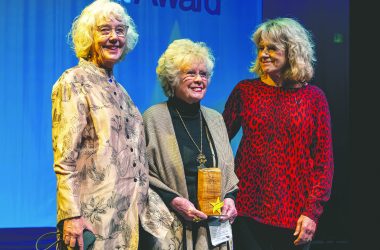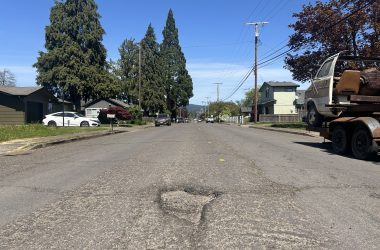 Museum Curator Madeline McGraw stands in front of her favorite display of petrified wood from the Springfield Thunderegg Rock Club for their new exhibit: ”Hidden Treasures – Rockhounding in Oregon.” Aliya Hall/The Chronicle
Museum Curator Madeline McGraw stands in front of her favorite display of petrified wood from the Springfield Thunderegg Rock Club for their new exhibit: ”Hidden Treasures – Rockhounding in Oregon.” Aliya Hall/The Chronicle
SPRINGFIELD – ”Rocks are unifying,” Museum Curator Madeline McGraw said about the Springfield Museum’s latest exhibit, ”Hidden Treasures: Rockhounding in Oregon,” which drew over 200 people of all ages to its opening last week.
The rocks, all collected in Oregon, were loaned to the exhibit by the Springfield Thunderegg Rock Club and will continue to be on display until the end of December. Along with the rockhounding exhibit, the museum also dedicated space to a small photo exhibit for Native American Heritage Month that will be up until the end of November.
McGraw said that for both exhibits, the ideas were brought to her. One of the members of the Springfield Thunderegg Rock Club had talked with McGraw four months ago about showcasing only thundereggs, but the more McGraw thought about it, she thought having a full exhibit dedicated to rockhounding would be fun.
”I always like to say with exhibits like this that I want people to leave on their phone googling how they can start doing that,” she explained.
There are around 200 rocks on display in the museum, all of them in different stages. Some have been polished or fashioned into jewelry, while others have just been cut and left unpolished or raw.
The rocks were loaned by 15 different club members; two of them, Darnell and Jean Hlavinka, had their own display case full of carnelians, which they found over the span of three to four years. Another club member from Cottage Grove found a large piece of petrified wood in his backyard, which is also on display.
The exhibit has been a hit with visitors of all ages, and McGraw is working on adding more interactive programming for kids. Along with worksheets and guessing the names of mystery rocks, she also wants to add a sand sifter for kids to hound for their own rocks.
On the walls behind the rockhounding exhibit, the museum is also highlighting a photo exhibit for Native American Heritage Month, which focuses on the Chifin Native Youth Center. Melissa Carino, senior planner with City Hall, worked with the center to bring in photos of indigenous children, as well as photos from Springfield Museum and Lane County History Museum archives. She also helped organize the Indigenous Peoples’ Day celebration.
”One thing that stuck out for me is how one leader pointed out the City has permanent exhibits honoring the pioneer and timber industry history of Springfield . . . but not much for the people and culture that existed prior to that,” she explained.
McGraw added that although the museum has done a decent job of not being too offensive, which many older museums struggle with, it still hasn’t been as inclusive as it should be.
”It’s been on my mind for a long time to try and make this an inclusive space,” she said. ”When we redesign the permanent exhibit, we’re going to do a lot more work in that direction, but we wanted to push more in that direction while we’re in this fluid moment of change.”
A few years ago, Carino spent time in the Philippines working with indigenous people and tribes, and she said the experience of helping put this exhibit together has been meaningful to her.
”While I can’t be in the Philippines, working with the indigenous peoples there, I can try and do the work where I am now and work with the local indigenous people,” she explained. ”This process was inspiring, collaborative and transformational, I think, for many people involved in this process.”
Carino and McGraw have talked about working more with the Confederated Tribes of the Grand Ronde Community, so the museum can make a space where ”we’re not telling other people’s stories, we’re giving them the space to tell their own stories,” McGraw said.
”It’s a small step but still really important,” she continued. ”It shows we still have indigenous people here; they’re not gone, they’re not part of the past, they’re here and very present.”
Carino added that she hopes people take away from the exhibit that indigenous people are diverse and part of a shared history as well as current times, and to not erase or dismiss them.
Next year, the museum will be changing their exhibit format. Instead of a new exhibit every two months, they will be having two six-month exhibits, which will allow for more programming and interaction with the work. The exhibits for 2020 will focus on the McKenzie River and the history of Glenwood.








